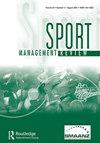Why don’t more college athletes engage in activism? A multilevel analysis of barriers to activism in the hegemonic arena of intercollegiate sport
IF 3.8
1区 教育学
Q1 HOSPITALITY, LEISURE, SPORT & TOURISM
引用次数: 2
Abstract
ABSTRACT Drawing from interviews with 31 collegiate athlete activists, the goal of this study was to identify barriers to athlete activism in the hegemonic arena of U.S. college sport. I utilize a multilevel analysis to map how activism is rendered counter-hegemonic, non-normative behavior in college sport through barriers manifesting at the macro-level (societal), meso-level (organizational), and micro-level (individual). Barriers at the macro-level include social norms prioritizing athlete identity and stigma attached to activism, while barriers at the meso-level include the strict regulation of athletes’ lives, isolation on campus, team cultural norms, and institutional power relations. Finally, emotional exhaustion and lack of rapport with peers manifested at the micro-level, further constituting barriers to activist efforts. The complex interplay of barriers at multiple levels, I argue, perpetuates a hegemonic order where contemporary collegiate athlete activists and the arena of sport become sites for the struggle for power – that is, cultural sites in which the battle between hegemonic forces and agents of resistance becomes manifested and visible. HIGHLIGHTS Collegiate activists face barriers to activism on many levels, ranging from macro-(societal) to meso- (organizational) and micro-levels (individual). There continues to be intense stigma attached to activist behaviors in U.S.intercollegiate sport, despite an increase in activism. On an emotional level, collegiate athlete activists often experience feelings of isolation and exhaustion. At the institutional level, unsupportive institutional climates and team cultural norms can prevent athletes from engaging in activism. The barriers identified serve as powerful hegemonic tools to render activism non-normative behavior in U.S.intercollegiate sport.为什么没有更多的大学运动员参与行动主义?校际体育霸权竞技场中行动主义障碍的多层次分析
本文章由计算机程序翻译,如有差异,请以英文原文为准。
求助全文
约1分钟内获得全文
求助全文
来源期刊

Sport Management Review
Multiple-
CiteScore
9.00
自引率
7.30%
发文量
27
期刊介绍:
Sport Management Review is published as a service to sport industries worldwide. It is a multidisciplinary journal concerned with the management, marketing, and governance of sport at all levels and in all its manifestations -- whether as an entertainment, a recreation, or an occupation. The journal encourages collaboration between scholars and practitioners. It welcomes submissions reporting research, new applications, advances in theory, and case studies. The language of publication is English. Submissions are peer reviewed.
 求助内容:
求助内容: 应助结果提醒方式:
应助结果提醒方式:


